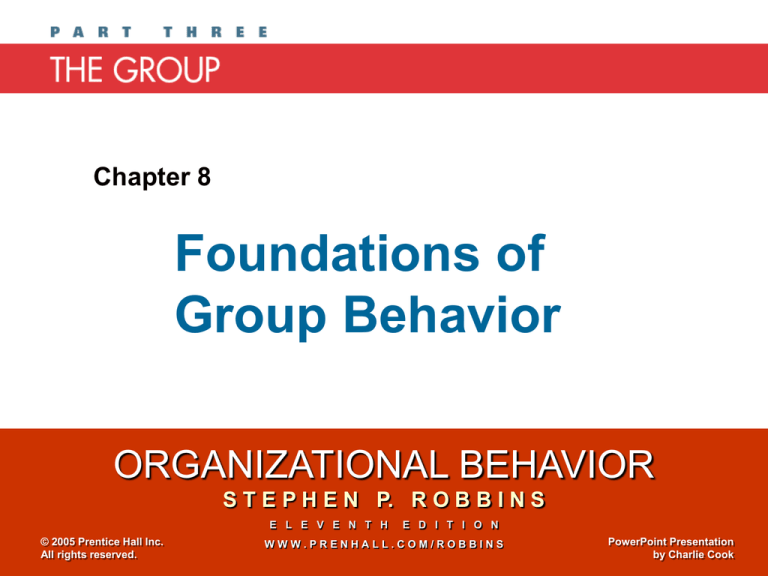
Chapter 8
Foundations of
Group Behavior
ORGANIZATIONAL BEHAVIOR
S T E P H E N P. R O B B I N S
E L E V E N T H
© 2005 Prentice Hall Inc.
All rights reserved.
E D I T I O N
WWW.PRENHALL.COM/ROBBINS
PowerPoint Presentation
by Charlie Cook
Defining and Classifying Groups
Group(s)
Two or more individuals interacting and
interdependent, who have come together
to achieve particular objectives.
Formal Group
Informal Group
A designated work
group defined by the
organization’s structure.
A group that is neither
formally structured now
organizationally determined;
appears in response to the
need for social contact.
© 2005 Prentice Hall Inc. All rights reserved.
8–2
Defining and Classifying Groups (cont’d)
Command Group
Task Group
A group composed of
the individuals who
report directly to a
given manager.
Those working together
to complete a job or task.
Interest Group
Friendship Group
Those working together
to attain a specific
objective with which
each is concerned.
Those brought together
because they share one
or more common
characteristics.
© 2005 Prentice Hall Inc. All rights reserved.
8–3
Why People Join Groups
• Security
• Status
• Self-esteem
• Affiliation
• Power
• Goal Achievement
© 2005 Prentice Hall Inc. All rights reserved.
8–4
The Five-Stage Model of Group Development
Forming Stage
The first stage in group development, characterized
by much uncertainty.
Storming Stage
The second stage in group development,
characterized by intragroup conflict.
Norming Stage
The third stage in group development, characterized
by close relationships and cohesiveness.
© 2005 Prentice Hall Inc. All rights reserved.
8–5
…Group Development (cont’d)
Performing Stage
The fourth stage in group development, when the
group is fully functional.
Adjourning Stage
The final stage in group development for temporary
groups, characterized by concern with wrapping up
activities rather than performance.
© 2005 Prentice Hall Inc. All rights reserved.
8–6
An Alternative Model: Temporary Groups with
Deadlines
PunctuatedEquilibrium Model
Temporary groups go
through transitions
between inertia and
activity.
Sequence of actions:
1. Setting group direction
2. First phase of inertia
3. Half-way point transition
4. Major changes
5. Second phase of inertia
6. Accelerated activity
© 2005 Prentice Hall Inc. All rights reserved.
8–7
Group Structure - Roles (cont’d)
Role(s)
A set of expected behavior patterns attributed to
someone occupying a given position in a social unit.
Role Identity
Certain attitudes and behaviors consistent with a
role.
Role Perception
An individual’s view of how he or she is supposed to
act in a given situation.
© 2005 Prentice Hall Inc. All rights reserved.
8–8
Group Structure - Roles (cont’d)
Role Expectations
How others believe a person should act in a given
situation.
Psychological Contract
An unwritten agreement that sets out what
management expects from the employee and vice
versa.
Role Conflict
A situation in which an individual is confronted by
divergent role expectations.
© 2005 Prentice Hall Inc. All rights reserved.
8–9
Group Structure - Norms
Norms
Acceptable standards of behavior within a group
that are shared by the group’s members.
Classes of Norms:
• Performance norms
• Appearance norms
• Social arrangement norms
• Allocation of resources
norms
© 2005 Prentice Hall Inc. All rights reserved.
8–10
The Hawthorne Studies
A series of studies undertaken by Elton Mayo at
Western Electric Company’s Hawthorne Works in
Chicago between 1924 and 1932.
Research Conclusions:
– Worker behavior and sentiments were closely related.
– Group influences (norms) were significant in affecting
individual behavior.
– Group standards (norms) were highly effective in
establishing individual worker output.
– Money was less a factor in determining worker output
than were group standards, sentiments, and security.
© 2005 Prentice Hall Inc. All rights reserved.
8–11








